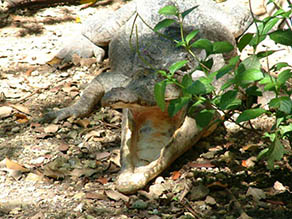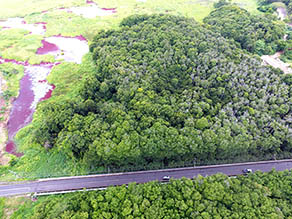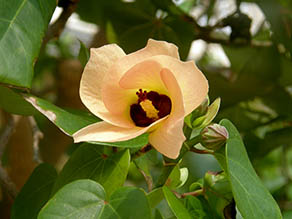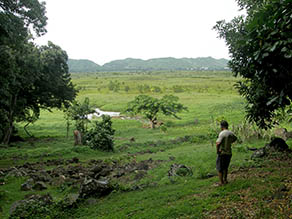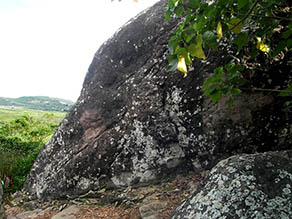 |
 |
 |
 |
||||||
|
|
|
|
|
|
|
|
|
|
 |
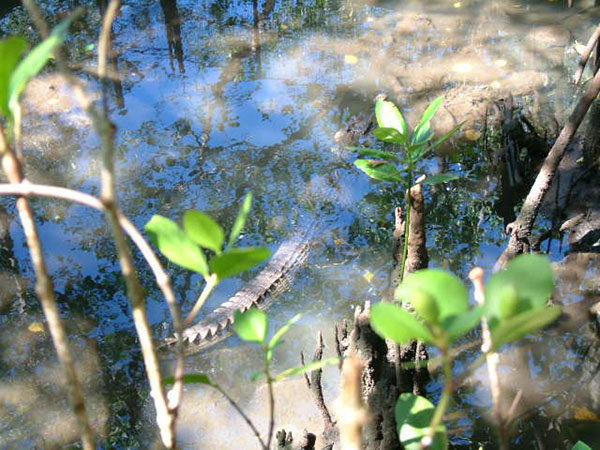
A crocodile amongst the mangroves in Palau.
“Next to Moloka‘i, Kāne‘ohe Bay area is the site of the most fish ponds,” Kalani explains, “and in every fish pond, it seems, there’s a mo‘o, a water spirit. Ultimately, the mo‘o is an ancestral recollection of the crocodile. Of course we have no crocodiles here in Hawai‘i. But crocodiles were experienced generations ago. Ocean-going crocodiles are big in northern Australia, Indonesia, and Melanesia, and those crocodiles even swim the sea up to Micronesia to Palau. The skeleton of a crocodile was found by archaeologists in Tonga. “So they got that far, and so the stories of crocodiles as mo‘o are very alive. In Tonga and New Zealand today, the tanifa/taniwha are big water spirits that are dangerous, inhabit rivers and they love to have people for dinner. So here in Hawai‘i we have stories, and they are in the landscape.” “Mo‘o in Hawaiian in thought, a lot of times we use the term 'mo‘o' loosely today to translate to being a gecko or a lizard,” Hi‘ilei points out, “kind a like your common household gecko or ones you see scouring around in the yard. But in Hawai‘i there are no native species of amphibians or reptiles besides the honu. That’s the only native reptile there is, so where is this idea of mo‘o come from? It’s traveled with our people from where we’ve come from, which is South Pacific. I think throughout the Pacific there’s stories of mo‘o whether they’re native to that place or not. Just so happens, Hawai‘i doesn’t have any native species of mo‘o per se. We have honu but that’s not a mo‘o. So the stories have come with our people.” “I think common knowledge is that He‘eia fishpond’s guardian is a mo‘o. She’s like our number-one guardian, and her name is Meheanu. Up in Ha‘akolea, there’s a mo‘o up there, Kamehaikana is a mo‘o, or further up our stream we have a mo‘o called Maka. Other fishponds have he‘e or sharks as their guardians. But I think the most fishponds are associated with a mo‘o. So Meheanu is our mo‘o. It’s a she, female. She’s a kupua, a shape-shifter, so she has an ability to change form. Her forms include a beautiful young woman, an elderly woman. In the fishpond, two of her common forms are that of a white eel and that of an ‘anae. ‘Anae is mullet fish, which is the keystone species of fishponds. “Her mauka residence is a place called Lua Mo‘o which is where Kanekoa folks are located, just across the bridge. I know the approximate location, not exact. It’s a watery hole but she traveled between her watery hole and the fishpond. “The story goes, you know that Meheanu is present by the color of the hau. Hau forms a nice barrier between us and the residents behind us. but two versions of the story is that when the leaves take on a yellowing hue, then you know she’s present. It’s sort of like a mo‘o because their skin and their eyes were known to be real yellow sort of, wherever they travel it’s the vegetation and foliage takes on the color of their skin and their eyes. My uncle was a historian and great storyteller, and he would tell me that the reason for that is because mo‘o, their mimi, the shishi, the urine is really putrid, really strong, really potent and that wherever they travel, that’s how the vegetation takes on its color. “The other version of the story is that you know that Meheanu is present by the color of the flower. Hau will produce a flower, and when it first opens, it will be yellow. That’s when Meheanu is present. Over the course of the day the flower turns red and then it falls off the tree and a lot of times you’ll see the red flowers floating around in the ocean or in the stream. But hau doesn’t flower all the time. It only flowers certain times, and so the coloring of the foliage and the coloring of the flower is how you tell Meheanu’s presence, and it’s always yellow. “In the old days, the story which my mom told us was about Meheanu the lizard goddess,” Alice says. “When it’s time to protect the fish pond, she would come in live on the hau trees. Meheanu was the kia‘i or the guardian of the fish pond. She most frequently liked to be an eel, but sometimes she would go across the street to the Ke‘alohi side, next to the lo‘i. The lo‘i, the river and then the next empty lot, that’s where the Meheanu used to frequent, on the mountain over here. When the hau flower gets yellow, it’s time for her to go and take care of the fishpond. When it turns green she’d go back to your home and stay there to the next blossom of yellow flowers. Meheanu.” “My husband had encountered Meheanu," Rocky relates. “This is funny: I said ‘I’ll never marry a Hawaiian.’ My husband was 100% Hawaiian. He was really my good friend. I don’t know how we ever got to get married. He was my sister’s dancing partner until my sister married her husband. They were just friends. And he knew this ocean, he knew this ‘āina like the back of his head, even knew the water. But he had encounters with Meheanu. 
“One day they were going out and they saw this giant eel. He said, ‘This eel must have been fat as a telephone pole.’ And he told this friend, ‘Don’t kill it!’ “And the guy said, ‘No, I got to. I have this brand-new three-prong spear.’ From the top he jumped—and this guy is really big—he jumped and my husband said that eel flew him across. When he looked at the spear, it’s all bent. My husband said, ‘I told you, don’t do that.’ “He said it was as long as the boat—at least 20 feet long,” Mahealani adds, “and his friend was trying to spear it so he could catch it and take it because it’s large, and lots of food from that.” “The eel whipped his tail and whacked this large Hawaiian right out of the boat! They had to pull him back into the boat right away so nothing would happen to him. So it’s a very strong, large eel. That’s Meheanu. When the hau flowers bloom, she’s present. When the flowers do not bloom, she’s visiting other places.” “And then another time,” Rocky continues, “he said they were fishing in the ocean and they caught an eel. We eat white eels. Some people don’t because it’s religious, but we do. And one of the eels actually curled up and came up like a snake to attack. So my brother-in-law, his brother was frozen. He got scared because it was like a snake attack. “Yeah, he had an encounter with Meheanu. This is right by the mouth of the river where you’re going to see Meheanu. I think she lives up inside in the back.” 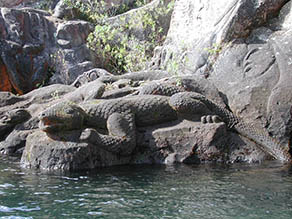
“In Hawaiian thought, mo‘o are guardians of water, fresh water,” Hi‘ilei continues. “Meaning, even though we’re brackish here, it’s understood that in order for a fishpond to function, the fresh water presence is of as equal importance as the salt water. The mixing is important and important to the mixing is you need the fresh water. So we have a mo‘o here. Many other fishponds have mo‘o, many other may be they’re natural water features throughout the ahupua‘a also have mo‘o associated with them.” “I have not encountered mo‘o, not in a visual sense, Keli‘i admits. “But there’s definitely times out here where you feel like you’re not alone, or you hear sounds in the bushes that it’s over in the hau and it’s nighttime and how did somebody get through the hau? It sounds like something big rustling through the leaves and who knows? could be a pig, could be a dog. So sounds and mostly feelings. “We’ve had different encounters that we can’t explain. We see her presence announced when the blossoms of the hau tree turn yellow. The story goes that it can be leaves as well. We know that there are things that happen around here that we can’t explain. I haven’t had personal contact with Meheanu, I know the former caretaker and operator of the fishpond tells the story of having an encounter with the mo‘o and that’s a pretty heavy story. “There are stories that Meheanu had a companion over in Kawainui marsh in Kailua, a mo‘o over there, the mo‘o’s name was Hauwahine. So girls like to hang out with each other. The mo‘o like to hang out with each other and the pilina, the connection between He‘eia fishpond, He‘eia wetland and marsh and Kailua wetland makes a lot of sense because these are areas that are very similar, the waters are very similar. "Kawainui is a wetland now but used to be a large inland fishpond. So same kind of waters, biology, smells, activities that you could do as a human, tastes, sounds, just things living very, very similarly. So it makes sense to me that if there’s a mo‘o here, that she was friends with the mo‘o over there.” “We do have a resident mo‘o,” Keoni says, of Waipao. “One of the spaces that we respect as her domain is Kapuna and the extended punawai in that area. There are different areas that she moves through, and our goal is to enhance those areas—to plant-up certain things in particular areas to suit her and make her feel comfortable. In the fish pond, there’s Meheanu. "I don’t personally know if Meheanu is coming up to our site and this is one of those places, or if it’s another mo‘o. I don’t have any particular knowledge of that. No one has shared particular knowledge of that with me. But we do know that there’s a mo‘o in our area. But I have not seen or heard particular mo‘o stories for our area, though I don’t think that we’ve looked thoroughly either." “We had a loko i‘a down here to this area which is called Punalu‘u,” Emalia says, “down there at the bay. The southern end of the bay is called Punalu‘u. There’s a subdivision below here, it goes down alongside the bay where it’s all been filled in. It’s Mahalani Circle, and was formerly a fishpond, a huge one, because we had about 30 of them on this Ko‘olaupoko coast, all the way up. My grandfather and my grandparents, they used to take care of one particular loko i‘a and my mother said that they would go down and of course feed all the pua i‘a—all the baby fish that would be let in so that they could raise them to eat them later. 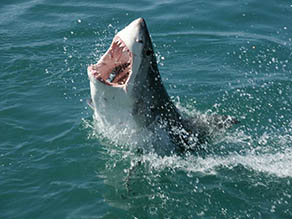
“But she did say that as a child she remembers stories from her grandmother about the bay, known for its mo‘owahine. This whole area, a lot of street names that commemorate a deity who was a mo‘o goddess and her name is Mā‘eli‘eli. There’s a peak over at He‘eia, that’s named for her, that honors her. "But she supposedly inhabits the bay. There are many streams where she’s been known to come up into. And my mother was telling me that nights of the full moon, she said this particular mo‘o wahine would come up out of the pond, sit on the banks of the pond where they were sitting, and just comb her hair in the moonlight. “So I said to mom, did Tūtū them describe her? She said no, they just had a word for her—a wahine hi‘u i‘a. according to them, she was a mythological female with a fishtail. So this is a term in Puku‘i’s dictionary and this is the way that she describes it. But mom said ‘Oh yeah’ and I would believe my grandparents. I mean I don’t think they made it up, they just didn’t have any need to do that. But they’re just repeating the stories, you have to pass them on. So that’s another thing she told me about this area down here where they used to go. It’s all filled in now for housing.” “Mo‘o guard water,” Hi‘ilei emphasizes, “and the reason for that is because our kūpuna acknowledged that you need to respect places where water is present. Water isn’t something that you can own. It’s something that everybody needs to have access to, and the water needs to be able to do its job. And the job of water is to produce life. So kind of acknowledging that, that’s why mo‘o were assigned to different areas: to guard that and protect that and ensure that the people that are managing and taking care of that space are being held accountable for their actions. And so that’s why mo‘o are revered and feared. But I think people don’t often think fondly of mo‘o. When people think of mo‘o they’re usually pretty scared of them and that’s with intent that it’s that way because they’re guarding water, and water is life.”
|
 |
 |
Another storied mo‘o of He‘eia—or, according to some traditions, the same one—is Mā‘eli‘eli herself.
|
 |
||
 |
|
 |
||

|
 |
||||
|
||||
Copyright 2019 Pacific Worlds & Associates • Usage Policy • Webmaster |
||||
